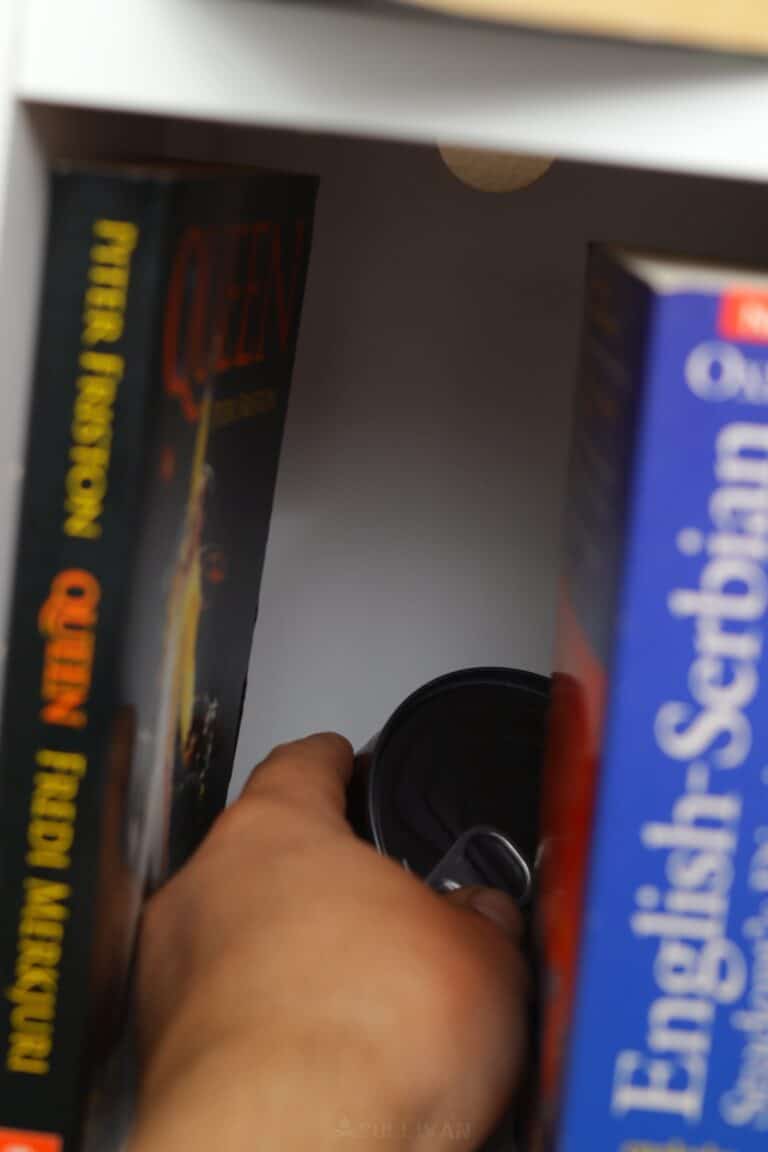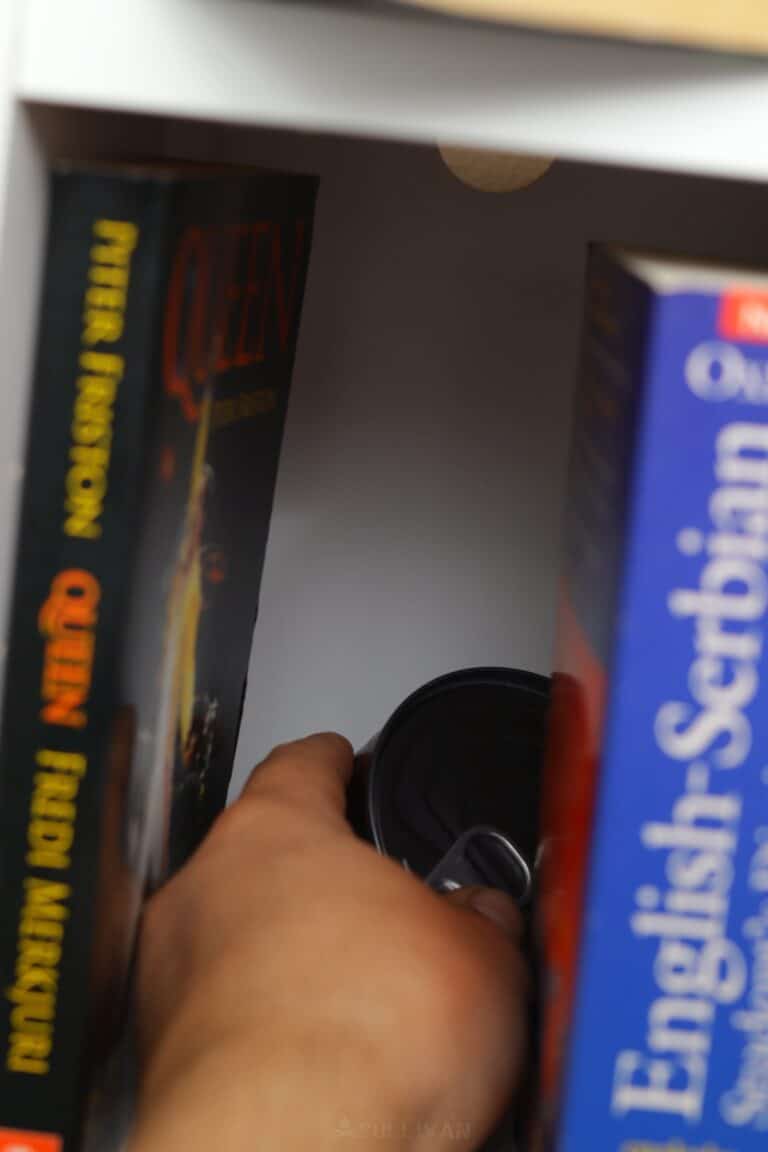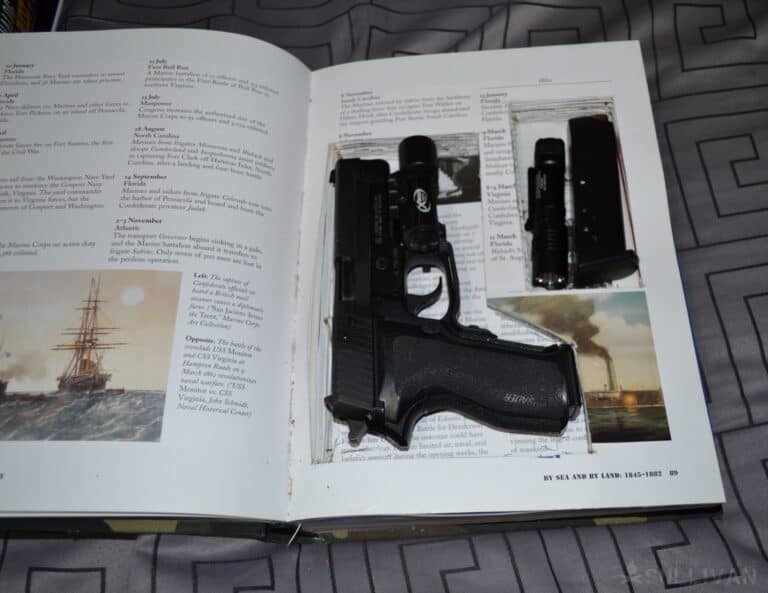

What’s the first thing you think of when you consider asset protection, and I mean physical assets? Probably a safe, right? Maybe an alarm system?
Whether you’re keeping cash, jewelry, gems, precious metals, critical documents, or anything else worth protecting, these traditional measures are certainly worthwhile but, sadly, increasingly vulnerable…
Smash-and-grab robbers will detach and haul away even large home safes and do so in minutes. Home invaders will move to neutralize you before robbing you blind.
Professional theft rings and cat burglars will strike when you aren’t around and then pick your house clean at their leisure.
I’m not saying you shouldn’t have a safe, but if you really want to keep your goods protected, you need a top-tier hiding place where these bad guys would never think to look.
From the subtle and sneaky to the incredibly clever, we’ll be looking at 13 such hiding places just below…

A Book Safe
This is a classic method of hiding valuables, and one that works particularly well if you have large and well-stocked bookcases in your home.
For those who aren’t already in the know, a book safe is nothing more than an actual book with a compartment cut out of its pages or a specially designed container that looks very much like a book, able to blend in with real ones.
Depending on the size of the book, you can store a quantity of jewelry, cash, or other small but important items in plain sight.
Only someone who knows what they’re looking for or cares enough to check every single book is likely to locate the stash easily, but you, of course, will be able to go right to it…
This is one hiding place that, however elegant it is, is also so well known it is basically a trope, and professional thieves that have time will rip books off shelves looking for such hiding places. Use with discretion!
Stashed Inside a Vent
A really clever way to hide valuables of all kinds is deep inside a vent.
Whether it is a floor vent with an elbow that curves out of sight or a horizontal vent that is either low or high on a wall, stashing your goods in a bag or other container and then shoving them back into the vent as far as you can is a great way to stash them.
Chances are any thieves that are ransacking your house will be on the clock and won’t waste time pulling hardware off the wall looking inside as long as it’s out of sight.
Obviously, this is not the most quickly accessible hiding place, and you must be careful of moisture, heat, or cold affecting your goods as appropriate. But for durable items, this is a great choice.
Inside a Thick Picture Frame
Another classic hiding place and one that works quite well as long as you don’t choose a frame housing a valuable-looking piece of art or keepsake.
Thick, ornate frames allow some standoff between the back of the frame, and the part that’s against the wall, and it is usually the backer board that supports whatever is mounted inside.
This space is perfect for flash drives, cash, and other small valuables.
Be careful to remove the felt or paper on the back of the frame to hide your stuff, and also take care that it can’t fall out while the frame is hanging on the wall.
But if you have some kitschy posters or cheap prints of ubiquitous works of art from the masters, this might be one of the best hiding places available to you and one that most thieves won’t think to check.
Use an Old Food Box or Bag
Far and away one of my very favorite hiding places for valuables, but one with some serious caveats, is simply to repurpose a food container to hide things in plain sight right in the kitchen or pantry.
It could be something like a box for saltine crackers or even an old bag of frozen peas.
Remove the food, or securely encase the valuables, and then put the container back where you would normally expect to find it. Simple as that!
But as you might have anticipated, you’ve got to be very careful with this technique: if you forget what you have stashed, it’s easy to accidentally throw away your valuables when cleaning house one day or rotating your goods.
Visiting company, friends, or family members might also inadvertently discover your stash innocently when trying to get a snack or prepare something to eat.
This probably isn’t the best trick for families for obvious reasons but is a flexible and effective technique for couples or single folks.
Among the Attic Clutter
Another time-tested approach to stashing valuables is simply to camouflage them among the many boxes and other knickknacks that people tend to accumulate in their attic or garage.
If you’re anything like me, you’ve got countless boxes of old inherited family junk, decorations for every major and minor holiday, abandoned projects, and things you just can’t get rid of for whatever reason…
As long as it doesn’t look overtly fancy, you can easily hide a box of real valuables somewhere in the mixture, and chances are very, very good that no thief will come across them.
But think twice before you commit to this plan: anything that’s stored in either of these locations is going to be subjected to intense heat or cold and potentially moisture, so proper packaging is a must.
In the Crawl Space
The crawl space is another location that is considered very low probability for investigation by thieves. The crawl space of most homes contains nothing but the furnace, pipes, crickets, cobwebs, and vapor barrier.
It sure isn’t convenient or pleasant for you to access either, but a well-chosen hiding spot somewhere down there is unlikely to ever be investigated, much less found.
A major risk factor associated with this location is flooding, for obvious reasons, as rising water that wouldn’t even reach the door of your home could still completely inundate the crawl space.
Behind a False Receptacle
A clever hiding spot that you can DIY yourself or install as a purpose-built module. Electrical receptacle boxes are small but ubiquitous and can hold a stash of jewelry, cash, and similar items.
All you need is the faceplate, the actual receptacle faces themselves, and the box, no wiring necessary. A little caulk or glue and a few minutes with a drywall saw, and you are in business.
If you’d rather have something that is easier to access on a whim, you can buy tiny “wall safes” that look identical but have a hinge that allows you to open them at will.
Either works fine and can be installed virtually anywhere and camouflaged by matching it to the hardware throughout your home.
Note that I recommend doing this with light switches unless you’re installing a single dummy switch in a larger switch panel; a single switch that doesn’t seem to do anything might arouse suspicion by searchers.
Under a Small Trash Can
Here is another technique that I use myself in the home office. You can easily install a false bottom compartment in a small trash can for hiding virtually anything you want, up to and including a handgun or a large quantity of cash.
If you don’t want to go through all that trouble, simply use a decoy trash can full of actual garbage like paper, junk mail, and so forth; just keep your goodies hidden at the very bottom and leave the trash in there.
Obviously, you don’t want to put any trash in the trash can which could rot, stain, or otherwise harm your stuff.
Inside the Frame of a Sofa or Loveseat
If you flip a sofa or loveseat onto its back, yours will probably have black or gray fabric stapled across the bottom that hides the interior structure that gives it shape.
By carefully pulling a corner or side of this fabric back, you can gain access to the interior and bolt or tape a container of valuables on the inside.
This will never be discovered, even accidentally, by visitors and is very likely to elude thieves who don’t have all the time in the world to do their nefarious work.
Just make sure you collect your goodies before you sell or throw away the furniture!
Inside a Waterproof Container Inside the Toilet Tank
This hiding spot has been around for a while and has a long and distinguished history of success. Who goes poking around inside the guts of a toilet looking for something to steal, after all?
Very obviously, anything you are going to hide inside a toilet tank must be completely waterproofed inside its container, and also not interfere with the function of the toilet itself.
This will necessitate the use of heavy-duty zipper locking bags, specialized dry bags, or completely watertight cases.
Using a Decoy Paint or Stain Bucket
This is probably the cleverest hiding place on the entire list. If you have an old paint bucket, a bucket of deck sealer, or anything like that that’s just been hanging out in your workshop, shed, or basement, you can clean out the interior but leave the outside nice and thrashed.
This will provide perfect camouflage for concealing your treasure among all the other things you would expect to find in such places.
If you have a variety of old paint cans and lots of tools, this method means it will blend in imperceptibly and only the most painstaking, centimeter-by-centimeter search would ever reveal it.
As you might have guessed already, the trick is to keep your chosen bucket in a location where it makes sense for it to be: for instance, most people don’t keep an old bucket of paint in the bottom of their pantry or master bedroom closet.
Hanging Under a Sink Stand
A small container or bag can be rigged to hang high up in the plumbing or above the upper jamb of a washstand or sink stand where it is very unlikely to be noticed by anyone who doesn’t get down on their hands and knees and look in there.
This hiding spot is also quite convenient for you and other authorized people to access, and compared to hiding stuff in the toilet tank like we discussed up above, the risk of water damage is greatly reduced as long as you stay on top of maintaining your plumbing.
My favorite approach is to actually mount a strong magnet above the door on the inside, and then glue the mating one to a small latching plastic box. It won’t shake or jiggle free, but I can easily pull it out with no fuss and no muss when I need to.
A Hidden Compartment
A true hidden compartment is limited only by your ingenuity, skill, and imagination. This could be a bespoke compartment hidden under a floor beneath removable slats, a false wall in the back of a closet, or anything else. You can do a search on YouTube for lots of ideas.
The trick to making a hidden compartment work for you is to make it completely invisible. This may require a level of craftsmanship or finish work that is beyond your current skill level.
The obvious solution to that is to hire someone with the skills to make it. But then again, doing that means there is a leak, at least one other person outside your circle of trust who knows where and what it is!
How you overcome this catch-22 is up to you, but if you are serious about using a hidden compartment for asset protection, it would be best if you figure out a way to install it yourself.


Tom Marlowe practically grew up with a gun in his hand, and has held all kinds of jobs in the gun industry: range safety, sales, instruction and consulting, Tom has the experience to help civilian shooters figure out what will work best for them.

